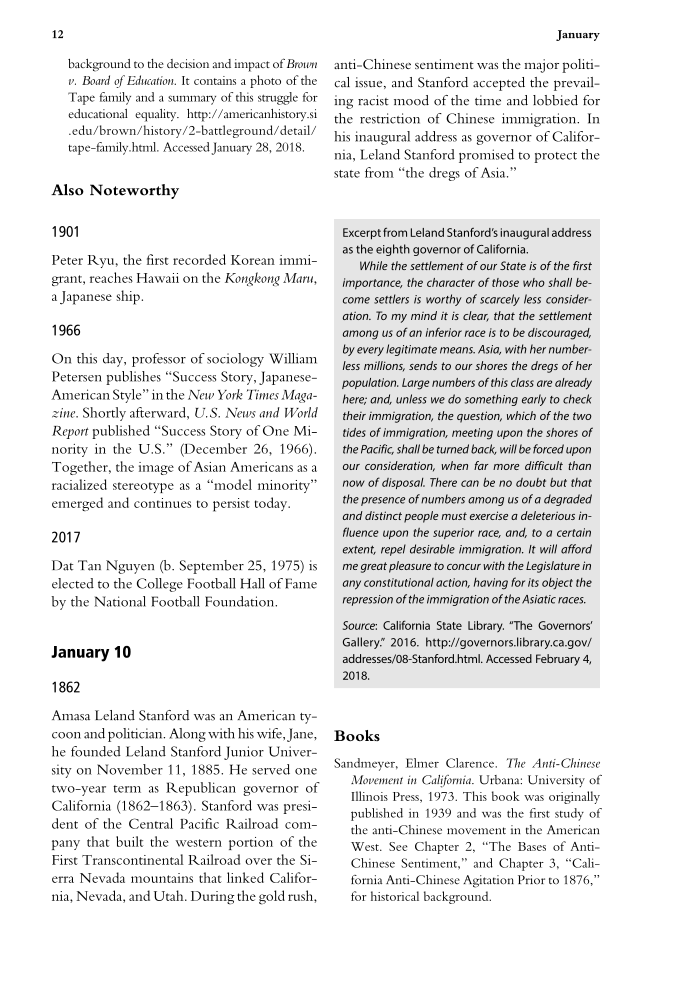12 January background to the decision and impact of Brown v. Board of Education . It contains a photo of the Tape family and a summary of this struggle for educational equality. http://americanhistory.si .edu/brown/history/2-battleground/detail/ tape-family.html. Accessed January 28, 2018. Also Noteworthy 1901 Peter Ryu, the first recorded Korean immi- grant, reaches Hawaii on the Kongkong Maru , a Japanese ship. 1966 On this day, professor of sociology William Petersen publishes “Success Story, Japanese- American Style” in the New York Times Maga- zine . Shortly afterward, U.S. News and World Report published “Success Story of One Mi- nority in the U.S.” (December 26, 1966). Together, the image of Asian Americans as a racialized stereotype as a “model minority” emerged and continues to persist today. 2017 Dat Tan Nguyen (b. September 25, 1975) is elected to the College Football Hall of Fame by the National Football Foundation. January 10 1862 Amasa Leland Stanford was an American ty- coon and politician. Along with his wife, Jane, he founded Leland Stanford Junior Univer- sity on November 11, 1885. He served one two-year term as Republican governor of California (1862–1863). Stanford was presi- dent of the Central Pacific Railroad com- pany that built the western portion of the First Transcontinental Railroad over the Si- erra Nevada mountains that linked Califor- nia, Nevada, and Utah. During the gold rush, anti-Chinese sentiment was the major politi- cal issue, and Stanford accepted the prevail- ing racist mood of the time and lobbied for the restriction of Chinese immigration. In his inaugural address as governor of Califor- nia, Leland Stanford promised to protect the state from “the dregs of Asia.” Excerpt from Leland Stanford’s inaugural address as the eighth governor of California. While the settlement of our State is of the first importance, the character of those who shall be- come settlers is worthy of scarcely less consider- ation. To my mind it is clear, that the settlement among us of an inferior race is to be discouraged, by every legitimate means. Asia, with her number- less millions, sends to our shores the dregs of her population. Large numbers of this class are already here and, unless we do something early to check their immigration, the question, which of the two tides of immigration, meeting upon the shores of the Pacific, shall be turned back, will be forced upon our consideration, when far more difficult than now of disposal. There can be no doubt but that the presence of numbers among us of a degraded and distinct people must exercise a deleterious in- fluence upon the superior race, and, to a certain extent, repel desirable immigration. It will afford me great pleasure to concur with the Legislature in any constitutional action, having for its object the repression of the immigration of the Asiatic races. Source: California State Library. “The Governors’ Gallery.” 2016. http://governors.library.ca.gov/ addresses/08-Stanford.html. Accessed February 4, 2018. Books Sandmeyer, Elmer Clarence. The Anti-Chinese Movement in California . Urbana: University of Illinois Press, 1973. This book was originally published in 1939 and was the fi rst study of the anti-Chinese movement in the American West. See Chapter 2, “The Bases of Anti- Chinese Sentiment,” and Chapter 3, “Cali- fornia Anti-Chinese Agitation Prior to 1876,” for historical background.
Document Details My Account Print multiple pages
Print
You have printed 0 times in the last 24 hours.
Your print count will reset on at .
You may print 0 more time(s) before then.
You may print a maximum of 0 pages at a time.






























































































































































































































































































































































































































































































